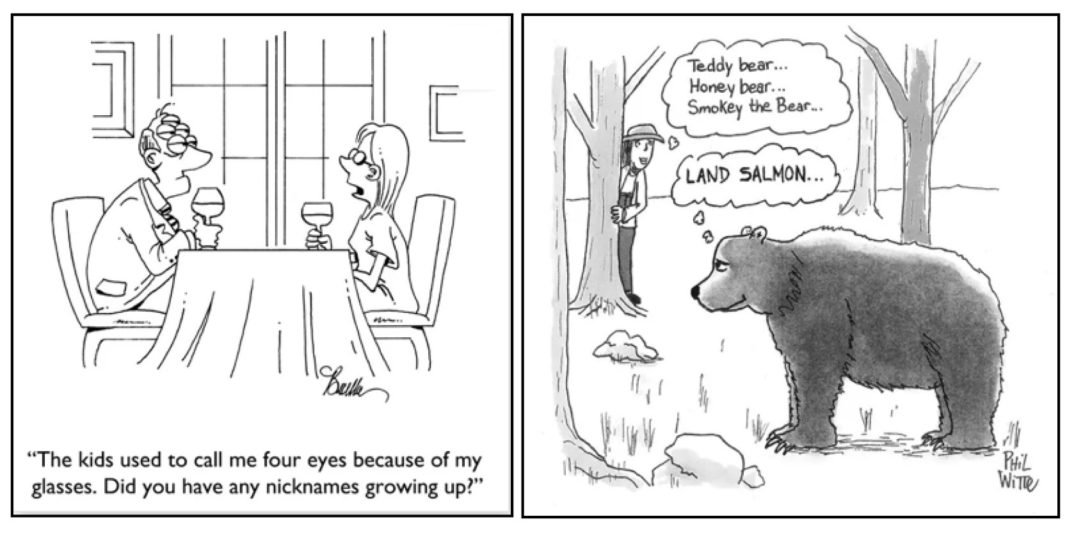Nick Name

Nick names are funny. Sometimes they stick forever. Sometimes they don’t. But when they do stick we tend wear them like a big ‘ol badge of honor.
Lefty, T Man, Snoop, Kevins, Sweetness, BooBoo, Missy, Big D, Monkey, A Rod, Papa, Max, Butcher, Finnigan, The Buckeyes, City of Lights, Slugger, Tinseltown, Slick Willie, – the list goes on and on. Nicknames are such a part of how we communicate with one another. When I was little, my big brother was in charge of all the family nicknames. It’s quite a list – (with 17 siblings and his incredibly vivid imagination, we all had multiple nicknames that will / must remain in the family! As I grew up, nicknames rolled on with me in HS, College, and married life I have a great group of friends that I’ve known for over 30 years, many of our nicknames unfortunately or fortunately can’t be listed or our wives would be less than happy! (something about wishing we would finally be growing up??). I did some digging, and of course found a ton of more famous names and stories behind them – sports, history, music, politics, movies, etc. Here’s some brief history of “eke” names. When you can give me a call, or shoot me an email – I’d love to hear your names and the stories too (skowalski@khtheat.com) Thanks to wikipedia, washingtonpost.com, and all those mentioned here – (your secret origin is safe with me!!)
- The compound word ekename, literally meaning “additional name”, was attested as early as 1303. This word was derived from the Old English phrase eac “also”, related to eacian “to increase”. By the 15th century, the misdivision of the syllables of the phrase “an ekename” led to its rephrasing as “a nekename” and common day nickname.
- Nicknames are to formal names what cartoons are to formal portraits, what slang is to formal language, what subjectivity is to objectivity, and, sometimes, what a graffiti mustache is to a face on an ad in the subway — a Bronx cheer from the peanut gallery. Nicknames have been codified, analyzed and interpreted by legions of linguists, sociologists and anthropologists.
- English nicknames are generally represented in quotes between the bearer’s first and last names (e.g., Dwight David “Ike” Eisenhower, Daniel Lamont “Bubba” Franks, etc.).
- Like English, German uses (German-style) quotation marks between the first and last names (e.g., Andreas Nikolaus „Niki“ Lauda). Other languages may use other conventions; for example, Italian writes the nickname after the full name followed by detto “called” (e.g., Salvatore Schillaci detto Totò). In Spanish the nickname is written in formal contexts at the end in quotes following alias (e.g. Alfonso Tostado, alias «el Abulense.
- In Viking societies, many people had heiti, viðrnefni, or kenningarnöfn (Old Norse terms for nicknames) which were used in addition to, or instead of, the first name. In some circumstances, the giving of a nickname had a special status in Viking society in that it created a relationship between the name maker and the recipient of the nickname, to the extent that the creation of a nickname also often entailed a formal ceremony and an exchange of gifts known in Old Norse as nafnfestr (‘fastening a name’).
- In England, some nicknames are traditionally associated with a person’s surname. A man with the surname ‘Clark’ will be nicknamed ‘Nobby’: the surname ‘Miller’ will have the nickname ‘Dusty’ (alluding to the flour dust of a miller at work): the surname ‘Adams’ has the nickname ‘Nabby’.
- Other English nicknames allude to a person’s origins. A Scotsman may be nicknamed ‘Jock’, an Irishman ‘Paddy’ (alluding to Saint Patrick, the patron saint of Ireland) or ‘Mick’ (alluding to the preponderance of Roman Catholicism in Ireland), and a Welshman may be nicknamed ‘Taffy’.
- Giving colorful nicknames to colorful public personalities is an old American custom, as old as Old Hickory, Old Rough and Ready, Old Blood and Guts, Old Fuss and Feathers, the Ol’ Perfesser and Old Blue Eyes — as old, in fact, as Old Muttonhead, which is what John Adams, the first vice president, called George Washington, the first president, who was also known by a more affectionate nickname, “The Father of Our Country.”
- Ever since America was invented, Americans have been inventing nicknames for public personalities, monikers that describe them or laud them or mock them, everything from Honest Abe to Tricky Dick to Slick Willie. American history can be written in a rollicking roll call of nicknames — the Swamp Fox, the Great Compromiser, the Little Giant, Stonewall, Buffalo Bill, Wild Bill, Billy the Kid, Calamity Jane, Lucky Lindy, Satchmo, Babe, Groucho, the Kingfish, the King, the Gipper, Air. The American landscape can also be mapped in nicknames — Jersey Joe Walcott, Philly Joe Jones, Broadway Joe Namath, Mississippi John Hurt, Memphis Minnie, Tennessee Williams, Utah Phillips, Minnesota Fats.
- Nicknames beget nicknames in weird ways. In the 1880s, an English serial killer is nicknamed Jack the Ripper. Sixty years later, an American painter named Jackson Pollock starts dripping paint on canvases and — presto! — somebody dubs him “Jack the Dripper.” A popular book and movie provide a new title for a Mafia chieftain — “The Godfather” — and pretty soon, singer James Brown proclaims himself “the Godfather of Soul.” Two decades later, a rapper named Rahzel proclaims himself “the Godfather of Noyze.”
- Back in the mid-’60s, Charles O. Finley, the owner of the Kansas City Athletics, signed a hot new pitching prospect named Jim Hunter. Finley asked the kid if he had a nickname. The kid said he didn’t. Finley immediately bestowed one — Catfish. It stuck.
- The most prolific media nicknamer of our day is ESPN broadcaster Chris Berman, who coins comic pseudo-nicknames for ballplayers — Roberto “Remember the” Alomar and Bobby “Bad to the” Bonilla and Bernard “Innocent Until Proven” Gilkey.
- Nicknames are also common among the kind of people who are not eager to advertise their real names — people who don’t generally hand out business cards, like gamblers and criminals and outlaw motorcyclists. Organized crime has its faults, but even its harshest critics can’t dispute that it has given America some great nicknames — Jimmy “The Weasel” Fratianno, Willie “The Rat” Cammisano, Charles “Cherry Nose” Gioe, Charlie “Monkey Face” Genker, Orazio “The Scourge” Tropea and many, many more.
- Not only is the mob a wonderful source of names with internal quotation marks, it’s also a treasure trove of names followed by “a k a,” which is short for “also known as,” a phrase never applied to anyone you’d want your daughter to marry. The greatest a k a list in human history appeared on the cover page of a 1988 lawsuit titled United States v. International Brotherhood of Teamsters. It listed no fewer than 24 a k a’s, including “Joey the Clown,” “Jackie the Lackey,” “Matty the Horse,” “The Snake,” “Fat Tony,” “Tony Pro,” “Tony Ripe” and “The Nutcracker.”
- Our American past can fill a page of folk heroes like the Babe and the Lone Eagle and the Georgia Peach as well as larger-than-life villains with names reminiscent of characters in the comic strips — Pretty Boy Floyd, Baby Face Nelson, Machine Gun Kelly. There were also comedians named Groucho, Harpo, Chico, Zeppo and Gummo. And ballplayers named Dizzy, Dazzy, Daffy, Ducky, Fuzzy, Gabby, Wee Willie and Pee Wee. Not surprisingly, when Walt Disney animated the Grimm’s fairy tale about seven unnamed dwarfs in 1938, he got into the spirit of the age and named them Sleepy, Sneezy, Happy, Grumpy, Bashful, Dopey and Doc.
- Many rappers and hip-hop musicians are pumping new life into the tired American nickname and the scholars of names are beginning to take notice. “The intent of a rap nickname is to communicate, Many include Slick Rick, Chill Will, Jazzy Joyce, Special Ed, Flavor Flav, Notorious B.I.G., Foxy Brown, Mista Sinista, Total Eclipse, Silkk the Shocker . . . could this be the advent of a new golden age?
- See how many you recognize: here’s a link to the top 100 in sports Some of my favorites: Magic, Broadway Joe, Say Hey Kid, The Rocket, Iceman, Pistol Pete, The Glide, Sir Charles, Big Papi, The Bird, and of course, The Great One.

::::::::::::::::::::::::::::::::::::::::::::::::::::::::::::::::::::::::::::::::::::::::::
DO YOU LIKE CONTESTS?
Me, too.
As you may know the Kowalski Heat Treating logo finds its way
into the visuals of my Friday posts.
I. Love. My. Logo.
One week there could be three logos.
The next week there could be 15 logos.
And sometimes the logo is very small or just a partial logo showing.
But there are always logos in some of the pictures.
So, I challenge you, my beloved readers, to count them and send me a
quick email with the total number of logos in the Friday post.
On the following Tuesday I’ll pick a winner from the correct answers
and send that lucky person some great KHT swag.
So, start counting and good luck!
Oh, and the logos at the very top header don’t count.
Got it? Good. :-))))
Have fun!!
::::::::::::::::::::::::::::::::::::::::::::::::::::::::::::::::::::::::::::::::::::::::::



